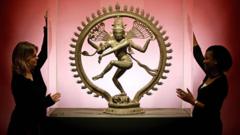The legacy of the Chola dynasty, which flourished from the 10th to the 13th centuries, is not only an exemplary tale of governance and cultural richness but also underscores India's significant role in global trade during the medieval era. This remarkable dynasty, particularly during the reign of King Rajaraja Chola, embarked on monumental constructions, including the awe-inspiring Brihadishvara Temple, completed in 1010 CE. Standing 216 feet tall and composed of 130,000 tonnes of granite, this temple is a testimony to Chola engineering and devotion, crowned with a golden representation of the Hindu god Shiva.
Before the Cholas rose to eminent power, they navigated the competitive landscape of the Kaveri floodplain in Tamil Nadu. Their radical transformation stemmed from a combination of military conquest and cultural promotion, characterized by pioneering queens like Sembiyan Mahadevi. Her efforts to bolster devotion through the ‘Nataraja’ image set the stage for a religious movement that ultimately popularized this form of Shiva, connecting spiritual devotion to royal identity.
Rajaraja Chola's reign involved not only spiritual consolidation but significant military campaigns, establishing Chola outposts in regions like Lanka and expanding into the Deccan Plateau. The spoils from these conquests were systematically directed into his grand temple, which served as the nucleus of welfare, providing vast resources towards agricultural advancements and public works, a pioneering model of state-led economic management.
Rajaraja's successor, Rajendra Chola, ventured beyond Indian shores, forging alliances with Tamil merchant guilds, thus replicating the model seen in later colonial enterprises. In 1026, he orchestrated a naval expedition to northern Malay, impacting regional trade dynamics and enabling Tamil merchants to thrive across Southeast Asia, including modern-day Indonesia and Myanmar. This movement stoked the growth of Tamil trade networks that reached as far as Quanzhou in Mongol-ruled China, where Tamil merchants established their own businesses and temples.
The grandeur of the Chola period saw the birth of dynamic marketplaces and vibrant temple towns, initiating a cultural and economic boom that rivaled the most advanced societies of the time. The Chola temples evolved into community centers, attracting a multitude of ethnic groups, including Chinese Buddhists and Tunisian Jews, creating a melting pot of cultures in Tamil Nadu.
Creatively, the Chola era produced some of the world's finest metalwork, with mythological themes brought to life through bronze sculptures that have left an indelible mark on art history. This rich tapestry of influences has extended to Tamil poetry, wherein notions of historicity and spirituality flourished, presaging literary movements that would emerge in subsequent centuries.
The vibrant cultural output and extensive trade connections established during the Chola dynasty underscore a critical chapter in human history, revealing the intricate ties that shaped global interactions long before modern globalization. Today, artifacts from the Chola period are celebrated in major museums worldwide, symbolizing a flourishing civilization that played a pivotal role in weaving the complex tapestry of our shared past.
Anirudh Kanisetti, an esteemed Indian writer, delves into this intricate history in his recent book, exploring the vast nuances of the Chola empire's influence.




















